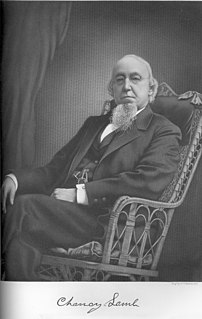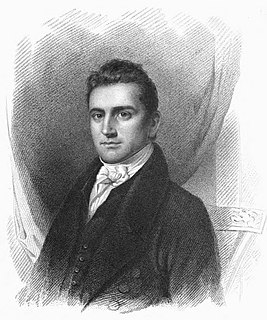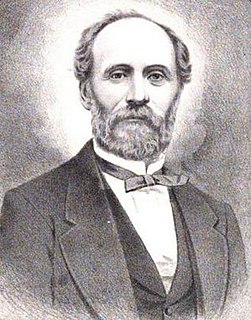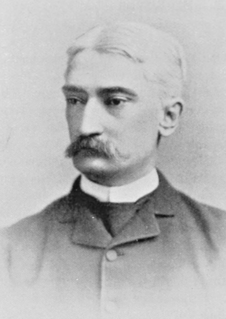
William S. Pitts (1830-1918) was an American physician and composer who wrote the well-known song "The Church in the Wildwood" in 1857.

William S. Pitts (1830-1918) was an American physician and composer who wrote the well-known song "The Church in the Wildwood" in 1857.
William Savage Pitts was born at Lums Corners within the town of Yates in Orleans County, New York on August 18, 1830 to Charles Pitts and Polly Green Smith Pitts who were descended from New England Puritans of English and Scottish ancestry. [1] [2] Pitts was the eighth of nine children and had musical ability from an early age, taking formal music lessons from a graduate of the Boston Handel and Haydn Society.
At age nineteen Pitts traveled with his family to Rock County, Wisconsin where he worked as a rural schoolteacher. [2] In 1857 Pitts traveled to Fredericksburg, Iowa to visit his fiancee, Ann Eliza Warren, a teacher, and along the journey he stopped in Bradford, Iowa. [3] [4] Pitts found particular beauty in a wooded valley formed by the Cedar River. While viewing the spot, Pitts envisioned a church building there and could not seem to ease the vision from his mind. Returning to his home in Wisconsin, he wrote "The Church in the Wildwood" for his own sake, eventually saying of its completion, "only then was I at peace with myself." [5]
By 1862 Pitts was married in Union, Wisconsin, and he and his wife moved to Fredericksburg to be near her elderly parents, and they remained there forty-four years and had three children. Upon his return to the Iowa, Pitts was surprised to find a church being erected where he had imagined it five years before. The building was even being painted brown, because that was the least expensive color of paint to be found and became known as The Little Brown Church. During the winter of 1863-64 he taught a singing class at Bradford Academy. Pitts had his class sing the song at the dedication of the new church in 1864. This was the first time the song was sung by anyone apart from Pitts himself. [6] [7]
In 1865, Pitts moved to Chicago, Illinois, to enroll in Rush Medical College. To pay his enrollment fees, he sold the rights to the song to a music publisher for $25. He completed medical school, graduating in 1868, but the song was largely forgotten for several decades. Pitts practiced medicine in Fredericksburg until 1906.
His first wife died in 1886 and Pitts remarried to Mrs. M.A. Grannis in 1887 and they moved to Clarion, Iowa in 1906. She died in 1909 and Pitts moved to Brooklyn, New York to be with his son, William Stanley Bates, that same year while William was working for the U.S. War Department.
Pitts joined Frederickburg's Baptist church in 1871, and upon moving to Clarion in 1906, he joined the Congregational church there in 1906. After moving to New York in 1909, Pitts joined the Dyker Heights Congregational Church in Brooklyn. [1] Pitts served as mayor of Fredericksburg for seven years, school treasurer for twenty-six years, wrote a biographical local history, and was a Master Freemason. Pitts occasionally performed his most famous song. He died in Brooklyn in September 25, 1918 and was buried in the Rose Hill Cemetery in Fredericksburg, Iowa. [1] [8]

Fredericksburg is a city in Chickasaw County, Iowa, United States. The population was 987 at the time of the 2020 census.
Amos Noë Freeman (1809—1893) was an African-American abolitionist, Presbyterian minister, and educator. He was the first full-time minister of Abyssinian Congregational Church in Portland, Maine, where he led a station on the Underground Railroad, and served for decades at Siloam Presbyterian Church in Brooklyn, New York.
Native Americans in the United States resided in what is now Iowa for thousands of years. The written history of Iowa begins with the proto-historic accounts of Native Americans by explorers such as Marquette and Joliet in the 1680s. Until the early 19th century Iowa was occupied exclusively by Native Americans and a few European traders, with loose political control by France and Spain.

Horace Boies served as the 14th Governor of Iowa from 1890 to 1894 as a member of the United States Democratic Party. Boies was the only Democrat to serve in that position from 1855 to 1933, a period of 78 years.

William Buell Sprague was an American Congregational and Presbyterian clergyman and compiler of Annals of the American Pulpit, a comprehensive biographical dictionary of the leading American Protestant Christian ministers who died before 1850.
"The Church in the Wildwood" is a song that was written by Dr. William S. Pitts in 1857 following a coach ride that stopped in Bradford, Iowa. It is a song about a church in a valley near the town, though the church was not actually built until several years later. In the years since, the church has become known simply as "the Little Brown Church".

William Adams was a noted American clergyman and academic.

John Coalter was a Virginia lawyer, plantation owner and judge, who served almost twenty years in the Virginia Supreme Court of Appeals.

Chancy Lamb was a pioneer in the lumber industry in Clinton, Iowa.

Elias Cornelius (1794–1832) was an American Christian missionary and ordained minister.
Alphonso George Kellam was an American lawyer, judge, and Republican politician. He was one of the original justices of the South Dakota Supreme Court, and previously served one term the Wisconsin State Assembly. He also served as a Union Army officer in the American Civil War.

"The Little Brown Church" is a historic church located at 2730 Cheyenne Avenue in Nashua, Iowa that was made famous by a song, "The Church in the Wildwood". The structure was completed in 1864.
Bradford is an unincorporated community in Chickasaw County, Iowa, United States.

West Park United Reformed Church is located in the West Park area of Harrogate, England, and is a Grade II listed building. It was designed in Nonconformist Gothic style as West Park Congregational Church by Lockwood & Mawson and completed in 1862 for around £5,000. Along with Belvedere Mansion across the road, it was intended as part of the prestigious entrance to the Victoria Park development. For the Congregationalists it was meant to house an increasing congregation of visitors brought to the spa town by the recently-built railways. It became a United Reformed church in 1972.
Luther Ellsworth Utterback was an American artist, primarily working in sculpture and painting. He was known for his large scale installations in public spaces and corporate buildings.
Arthur Howe Bradford was a notable Congregational minister and preacher.

Orrin Henry Ingram was an American lumber baron and philanthropist from Eau Claire, Wisconsin. Orphaned at age 11, he established sawmills in Ontario, Canada, and the Chippewa Valley of Wisconsin. He was a banker and philanthropist in Eau Claire.
Phoebe Hinsdale Brown was the first notable American woman hymnwriter, and the first American woman to write a hymn of wide popularity, "I love to steal awhile away".

Luther Hall Foster was a nineteenth century businessman and lumber tycoon known for helping to develop various lumber businesses.

John Lathrop was an associate justice of the Supreme Judicial Court of Massachusetts.
{{cite web}}: CS1 maint: archived copy as title (link)